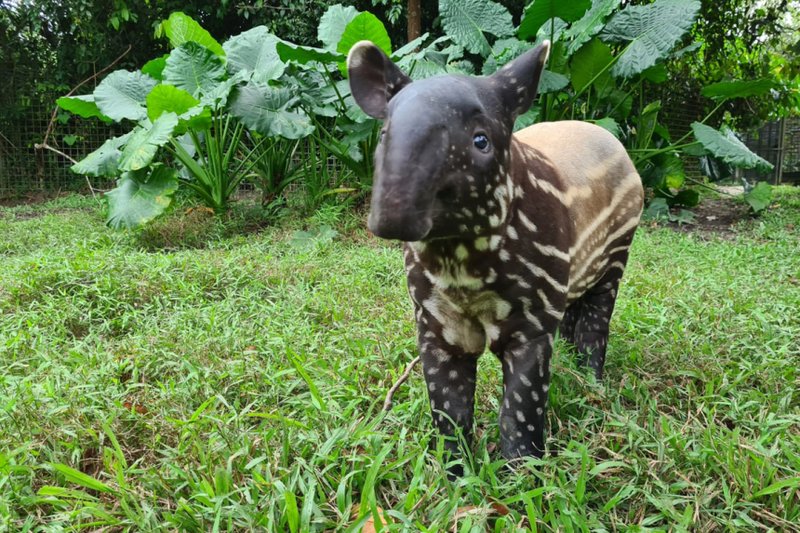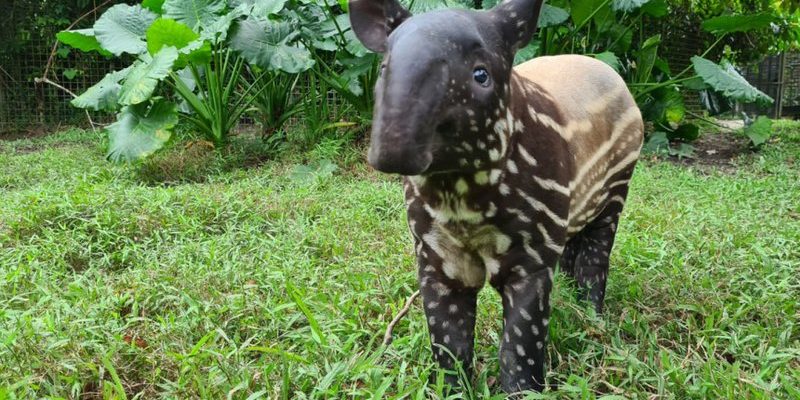
In this article, we’ll explore ten animals that resemble tapirs, diving into their similarities and differences. Think of it as an animal comparison guide for those of us who love spotting interesting creatures in nature. It’s important to appreciate the wonderful world of biodiversity, and understanding how these animals relate can deepen your connection with the wildlife around us.
1. Pigs
Pigs are probably the closest relatives to tapirs when you think about their stout bodies and sturdy legs. Both belong to the same order, called Perissodactyla, which means they have an odd number of toes. While tapirs are known for their long, flexible snouts, pigs have shorter, more rounded muzzles.
You might find it interesting that pigs can weigh significantly less than tapirs, which can weigh up to 800 pounds. Also, pigs are generally found on farms or in the wild, while tapirs prefer warmer, forested areas. So, when you’re wandering through a farm or nature reserve, keep an eye out for these two cousins and observe their distinct personalities and habitats.
2. Hippopotamuses
Another fascinating animal that resembles the tapir is the hippopotamus. Both creatures have a similar body shape—bulky and massive—making them look like they could be long-lost siblings. However, hippos are primarily aquatic and spend much of their time submerged in rivers and lakes.
You might be wondering how to tell them apart. While tapirs have a more elongated snout, hippos have wide mouths filled with large teeth. Additionally, hippos have a smoother, hairless body compared to the tapir’s coarse fur. Just imagine spotting a tapir in a rainforest versus a hippo lounging in the water—there’s no mistaking their preferred lifestyles!
3. Manatees
You might not immediately think of manatees when considering animals similar to tapirs, but they share some interesting traits. Both are large, gentle creatures that prefer warm environments, like tropical waters for manatees and lush jungles for tapirs.
What sets them apart is their habitat and appearance. Manatees are aquatic with paddle-like flippers and a flattened tail, while tapirs are terrestrial with stout legs and a unique trunk-like snout. If you’ve ever seen a manatee gliding through warm waters, you can appreciate the grace it brings, just as a tapir does when it walks quietly through thick foliage.
4. Rhino
Tapping into the more robust side of the family tree, we find the rhino. Remember, both rhinos and tapirs are odd-toed ungulates, meaning they share a similar evolutionary background. Rhinos are massive and often have one or two prominent horns on their snouts, which tapirs lack.
Despite their size, rhinos also have a gentle demeanor and are primarily herbivorous, just like tapirs. As you learn to identify these magnificent creatures, their differing habitats—savannas and grasslands for rhinos versus forests for tapirs—can be a helpful clue.
5. Elephants
Moving up the scale in size, it’s hard not to mention elephants. While they may seem quite different at first glance, both tapirs and elephants share a few features: a rounded body and a trunk-like structure. Instead of a long snout, elephants have a significant trunk, which they use for feeding and communication.
One of the most noticeable differences is size. An adult elephant can weigh up to six tons, while a tapir rarely exceeds 800 pounds. You might also find elephants in open savannas, while tapirs prefer thick jungle cover, showcasing their ways of life that are as distinct as their appearances.
6. Aardvarks
At first, you might be scratching your head at the comparison between aardvarks and tapirs. However, both animals share a quirky charm and a knack for digging. Aardvarks have long, pointed snouts that help them forage for insects, while tapirs have a more rounded, flexible snout suited for reaching leaves and fruits in the forest.
When it comes to size, aardvarks are smaller than tapirs, weighing about 150 pounds, while tapirs boast more substantial figures. Spotting these two creatures in their respective habitats can be quite the challenge, given their nocturnal habits—so if you’re out at night, keep an eye out for signs of either one.
7. Capybaras
The capybara is another interesting comparison. As South America’s largest rodent, it has a stout body similar to that of a tapir. Both animals enjoy a semi-aquatic lifestyle, often found near water sources.
However, capybaras are more social creatures and live in groups, while tapirs are typically solitary. Plus, capybaras have a more elongated face and do not possess the distinct snout of the tapir. If you see a group of capybaras lounging by the water, the contrast between their lighter fur and the tapir’s darker coat makes them easy to differentiate.
8. Koalas
While it may seem a stretch, koalas offer a fascinating comparison due to their gentle and laid-back nature. Both tapirs and koalas are herbivores, munching on plants to survive. However, koalas are marsupials and have a much smaller frame, weighing around 30 pounds.
Their biggest difference, of course, lies in their habitats and appearances. Koalas reside in eucalyptus trees in Australia, while tapirs roam the jungles of South America and Asia. If you encounter both in conversation or the wild, remember their unique lifestyles and adaptations that set them apart.
9. Warthogs
Speaking of peculiar faces, warthogs share some similarities with tapirs, especially with their stocky builds and tusks. Both are grounded creatures, often seen foraging for food in muddy areas.
The main distinction is in their appearance and behavior. Warthogs have distinct facial warts and tusks that give them a rugged look, which tapirs lack. While tapirs prefer dense forests, warthogs are often found in open grasslands and can be quite social, sometimes seen in groups. Spotting these two can be fun, and recognizing their differences is part of the joy of wildlife observation.
10. Sloths
Finally, let’s talk about sloths. These laid-back creatures share the jungles with tapirs, but they are much smaller and more arboreal. Both animals enjoy a diet rich in foliage, but while the tapir roams the ground, sloths spend most of their lives hanging from trees.
The differences are quite clear: sloths are known for their slow movements and long claws used for climbing, while tapirs are swift on their feet, navigating through dense underbrush. Observing these two can highlight the diversity of jungle life and how creatures adapt to their environments.
As you can see, there are plenty of animals that resemble the funky tapir, each with their unique traits and quirks. Whether it’s the stout pigs, colossal hippos, or even the gentle capybara, these creatures add to the rich tapestry of wildlife. Understanding the similarities and differences helps us appreciate the beauty of nature even more. Next time you find yourself in a zoo, wildlife park, or even just exploring nature, remember these comparisons and enjoy the fascinating world around you!

